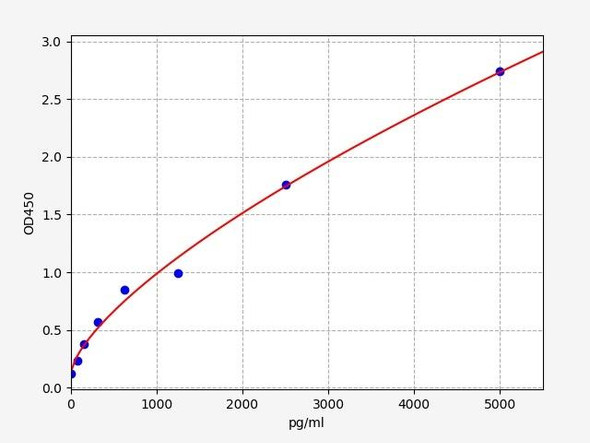Human RAP1B (Ras-related protein Rap-1b) ELISA Kit (HUFI08569)
- SKU:
- HUFI08569
- Product Type:
- ELISA Kit
- Size:
- 96 Assays
- Uniprot:
- P61224
- Sensitivity:
- 0.094ng/ml
- Range:
- 0.156-10ng/ml
- ELISA Type:
- Sandwich
- Synonyms:
- GTP binding protein smg p21B, K REV, RAL1B, RAP1B, Ras related protein Rap 1b
- Reactivity:
- Human
Description
Human RAP1B (Ras-related protein Rap-1b) ELISA Kit (HUFI08569)
The Human RAP1B (Ras-related Protein RAP-1B) ELISA Kit is specifically designed for the accurate quantification of RAP1B levels in human serum, plasma, and cell culture supernatants. This high-quality kit offers exceptional sensitivity and specificity, ensuring precise and consistent results for a variety of research applications.RAP1B is a key protein involved in signal transduction pathways, cell adhesion, and cell migration. Its dysregulation has been implicated in various diseases, including cancer, cardiovascular disorders, and neurological conditions.
Therefore, measuring RAP1B levels can provide valuable insights into disease mechanisms and potential therapeutic targets.With the Human RAP1B ELISA Kit, researchers can confidently analyze RAP1B expression levels in different sample types, facilitating the study of cellular processes and disease pathogenesis. Trust in the reliability and accuracy of this kit for your research needs.
| Product Name: | Human RAP1B (Ras-related protein Rap-1b) ELISA Kit |
| Product Code: | HUFI08569 |
| Size: | 96 Assays |
| Alias: | GTP binding protein smg p21B ELISA Kit, K REV ELISA Kit, RAL1B ELISA Kit, RAP1B ELISA Kit, Ras related protein Rap 1b ELISA Kit |
| Detection method: | Sandwich ELISA, Double Antibody |
| Application: | This immunoassay kit allows for the in vitro quantitative determination of Human RAP1B (Ras-related protein Rap-1b) concentrations in serum plasma and other biological fluids. |
| Sensitivity: | < 0.094ng/ml |
| Range: | 0.156-10ng/ml |
| Storage: | 4°C for 6 months |
| Note: | For Research Use Only |
| Recovery: | Matrices listed below were spiked with certain level of Human RAP1B (Ras-related protein Rap-1b) and the recovery rates were calculated by comparing the measured value to the expected amount of Human RAP1B (Ras-related protein Rap-1b) in samples. Enquire for more information. |
| Linearity: | The linearity of the kit was assayed by testing samples spiked with appropriate concentration of Human RAP1B (Ras-related protein Rap-1b) and their serial dilutions. The results were demonstrated by the percentage of calculated concentration to the expected. Enquire for more information. |
| CV(%): | Intra-Assay: CV<8% Inter-Assay: CV<10% |
| Component | Quantity | Storage |
| ELISA Microplate (Dismountable) | 8×12 strips | 4°C for 6 months |
| Lyophilized Standard | 2 | 4°C/-20°C |
| Sample/Standard Dilution Buffer | 20ml | 4°C |
| Biotin-labeled Antibody(Concentrated) | 120ul | 4°C (Protect from light) |
| Antibody Dilution Buffer | 10ml | 4°C |
| HRP-Streptavidin Conjugate(SABC) | 120ul | 4°C (Protect from light) |
| SABC Dilution Buffer | 10ml | 4°C |
| TMB Substrate | 10ml | 4°C (Protect from light) |
| Stop Solution | 10ml | 4°C |
| Wash Buffer(25X) | 30ml | 4°C |
| Plate Sealer | 5 | - |
Other materials and equipment required:
- Microplate reader with 450 nm wavelength filter
- Multichannel Pipette, Pipette, microcentrifuge tubes and disposable pipette tips
- Incubator
- Deionized or distilled water
- Absorbent paper
- Buffer resevoir
| UniProt Protein Function: | RAP1B: GTP-binding protein that possesses intrinsic GTPase activity. Contributes to the polarizing activity of KRIT1 and CDH5 in the establishment and maintenance of correct endothelial cell polarity and vascular lumen. Required for the localization of phosphorylated PRKCZ, PARD3 and TIAM1 to the cell junction. Heterodimer with RAP1GAP. Interacts with EPAC2, SGSM1, SGSM2 and SGSM3. Activated by binding to the GTPase-activating protein RAP1GAP. Activated by guanine nucleotide-exchange factor (GEF) EPAC2 in a cAMP-dependent manner. Belongs to the small GTPase superfamily. Ras family. |
| UniProt Protein Details: | Protein type:G protein, monomeric, Ras; G protein, monomeric; G protein Chromosomal Location of Human Ortholog: 12q14 Cellular Component: membrane; plasma membrane; lipid particle; intracellular; intercellular junction; cytosol; lipid raft Molecular Function:GTPase activity; protein binding; GDP binding; GTP binding; protein complex binding Biological Process: platelet activation; cell proliferation; microvillus biogenesis; negative regulation of calcium ion-dependent exocytosis; metabolic process; blood coagulation; Rap protein signal transduction |
| NCBI Summary: | This gene encodes a member of the RAS-like small GTP-binding protein superfamily. Members of this family regulate multiple cellular processes including cell adhesion and growth and differentiation. This protein localizes to cellular membranes and has been shown to regulate integrin-mediated cell signaling. This protein also plays a role in regulating outside-in signaling in platelets. Alternate splicing results in multiple transcript variants. Pseudogenes of this gene are found on chromosomes 3, 5, 6 and 9. [provided by RefSeq, Oct 2011] |
| UniProt Code: | P61224 |
| NCBI GenInfo Identifier: | 47117723 |
| NCBI Gene ID: | 5908 |
| NCBI Accession: | P61224.1 |
| UniProt Related Accession: | P61224 |
| Molecular Weight: | |
| NCBI Full Name: | Ras-related protein Rap-1b |
| NCBI Synonym Full Names: | RAP1B, member of RAS oncogene family |
| NCBI Official Symbol: | RAP1B |
| NCBI Official Synonym Symbols: | K-REV; RAL1B |
| NCBI Protein Information: | ras-related protein Rap-1b |
| UniProt Protein Name: | Ras-related protein Rap-1b |
| UniProt Synonym Protein Names: | GTP-binding protein smg p21B |
| Protein Family: | Ras-related protein |
| UniProt Gene Name: | RAP1B |
| UniProt Entry Name: | RAP1B_HUMAN |
*Note: Protocols are specific to each batch/lot. For the correct instructions please follow the protocol included in your kit.
Before adding to wells, equilibrate the SABC working solution and TMB substrate for at least 30 min at 37 °C. When diluting samples and reagents, they must be mixed completely and evenly. It is recommended to plot a standard curve for each test.
| Step | Protocol |
| 1. | Set standard, test sample and control (zero) wells on the pre-coated plate respectively, and then, record their positions. It is recommended to measure each standard and sample in duplicate. Wash plate 2 times before adding standard, sample and control (zero) wells! |
| 2. | Aliquot 0.1ml standard solutions into the standard wells. |
| 3. | Add 0.1 ml of Sample / Standard dilution buffer into the control (zero) well. |
| 4. | Add 0.1 ml of properly diluted sample ( Human serum, plasma, tissue homogenates and other biological fluids.) into test sample wells. |
| 5. | Seal the plate with a cover and incubate at 37 °C for 90 min. |
| 6. | Remove the cover and discard the plate content, clap the plate on the absorbent filter papers or other absorbent material. Do NOT let the wells completely dry at any time. Wash plate X2. |
| 7. | Add 0.1 ml of Biotin- detection antibody working solution into the above wells (standard, test sample & zero wells). Add the solution at the bottom of each well without touching the side wall. |
| 8. | Seal the plate with a cover and incubate at 37 °C for 60 min. |
| 9. | Remove the cover, and wash plate 3 times with Wash buffer. Let wash buffer rest in wells for 1 min between each wash. |
| 10. | Add 0.1 ml of SABC working solution into each well, cover the plate and incubate at 37 °C for 30 min. |
| 11. | Remove the cover and wash plate 5 times with Wash buffer, and each time let the wash buffer stay in the wells for 1-2 min. |
| 12. | Add 90 µL of TMB substrate into each well, cover the plate and incubate at 37 °C in dark within 10-20 min. (Note: This incubation time is for reference use only, the optimal time should be determined by end user.) And the shades of blue can be seen in the first 3-4 wells (with most concentrated standard solutions), the other wells show no obvious color. |
| 13. | Add 50 µL of Stop solution into each well and mix thoroughly. The color changes into yellow immediately. |
| 14. | Read the O.D. absorbance at 450 nm in a microplate reader immediately after adding the stop solution. |
When carrying out an ELISA assay it is important to prepare your samples in order to achieve the best possible results. Below we have a list of procedures for the preparation of samples for different sample types.
| Sample Type | Protocol |
| Serum | If using serum separator tubes, allow samples to clot for 30 minutes at room temperature. Centrifuge for 10 minutes at 1,000x g. Collect the serum fraction and assay promptly or aliquot and store the samples at -80°C. Avoid multiple freeze-thaw cycles. If serum separator tubes are not being used, allow samples to clot overnight at 2-8°C. Centrifuge for 10 minutes at 1,000x g. Remove serum and assay promptly or aliquot and store the samples at -80°C. Avoid multiple freeze-thaw cycles. |
| Plasma | Collect plasma using EDTA or heparin as an anticoagulant. Centrifuge samples at 4°C for 15 mins at 1000 × g within 30 mins of collection. Collect the plasma fraction and assay promptly or aliquot and store the samples at -80°C. Avoid multiple freeze-thaw cycles. Note: Over haemolysed samples are not suitable for use with this kit. |
| Urine & Cerebrospinal Fluid | Collect the urine (mid-stream) in a sterile container, centrifuge for 20 mins at 2000-3000 rpm. Remove supernatant and assay immediately. If any precipitation is detected, repeat the centrifugation step. A similar protocol can be used for cerebrospinal fluid. |
| Cell culture supernatant | Collect the cell culture media by pipette, followed by centrifugation at 4°C for 20 mins at 1500 rpm. Collect the clear supernatant and assay immediately. |
| Cell lysates | Solubilize cells in lysis buffer and allow to sit on ice for 30 minutes. Centrifuge tubes at 14,000 x g for 5 minutes to remove insoluble material. Aliquot the supernatant into a new tube and discard the remaining whole cell extract. Quantify total protein concentration using a total protein assay. Assay immediately or aliquot and store at ≤ -20 °C. |
| Tissue homogenates | The preparation of tissue homogenates will vary depending upon tissue type. Rinse tissue with 1X PBS to remove excess blood & homogenize in 20ml of 1X PBS (including protease inhibitors) and store overnight at ≤ -20°C. Two freeze-thaw cycles are required to break the cell membranes. To further disrupt the cell membranes you can sonicate the samples. Centrifuge homogenates for 5 mins at 5000xg. Remove the supernatant and assay immediately or aliquot and store at -20°C or -80°C. |
| Tissue lysates | Rinse tissue with PBS, cut into 1-2 mm pieces, and homogenize with a tissue homogenizer in PBS. Add an equal volume of RIPA buffer containing protease inhibitors and lyse tissues at room temperature for 30 minutes with gentle agitation. Centrifuge to remove debris. Quantify total protein concentration using a total protein assay. Assay immediately or aliquot and store at ≤ -20 °C. |
| Breast Milk | Collect milk samples and centrifuge at 10,000 x g for 60 min at 4°C. Aliquot the supernatant and assay. For long term use, store samples at -80°C. Minimize freeze/thaw cycles. |









